| Srl | Item |
| 1 |
ID:
099230
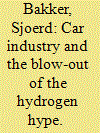

|
|
|
|
|
| Publication |
2010.
|
| Summary/Abstract |
The hydrogen hype of the last decade has passed and it is now seemingly substituted by the electric vehicle hype. A technological hype can have both positive as well as negative consequences. On the one hand it attracts sponsors for technology development but on the other hand the high expectations might result in disappointment and subsequent withdrawal of the sponsors. In this paper I ask the question to what extent the car industry has created the hype and how it has done so. The industry's role is studied through their prototyping activities and accompanying statements on market entry. I conclude that the car industry has indeed inflated the hype, especially through its public statements on market release after the turn of the millennium. Furthermore, it can be concluded that the industry has shown a double repertoire of both highly optimistic and more modest statements. It is possible that statements are used deliberately to serve the industry's interests whenever needed. Without neglecting the positive influence of technological hype on public policy and private funding for R&D efforts, more modest promises could serve the development of sustainable mobility better. For policy makers the challenge is to remain open to different options instead of following hypes and disappointments as they come and go.
|
|
|
|
|
|
|
|
|
|
|
|
|
|
|
|
| 2 |
ID:
144824
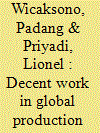

|
|
|
|
|
| Summary/Abstract |
Despite growing investment from leading automotive makers, particularly Japanese companies, the Indonesian automotive sector is still struggling to ensure decent work. This article makes a particular attempt to analyse the close links between Decent Work (DW) and Global Production Networks (GPNs) in the Indonesian automotive sector, whilst scrutinizing the existing literature that has covered the two concepts in separate frameworks. More specifically, this article examines the employment opportunities and adequate earnings of local employees within the DW framework in the country’s automotive sector with the expansion of GPNs. It finds that although there were greater opportunities for skilled workers to upgrade capabilities and enjoy improved welfare outcomes, there are still many more less-skilled workers remaining in precarious conditions.
|
|
|
|
|
|
|
|
|
|
|
|
|
|
|
|
| 3 |
ID:
035854
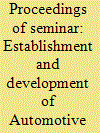

|
|
|
|
|
| Edition |
Part 1.
|
| Publication |
New York, United Nations Publications, 1970.
|
| Description |
123p.
|
|
|
|
|
|
|
|
|
|
|
|
Copies: C:1/I:0,R:0,Q:0
Circulation
| Accession# | Call# | Current Location | Status | Policy | Location |
| 005431 | 338.476292/UN 005431 | Main | Withdrawn | General | |
|
|
|
|
| 4 |
ID:
124893
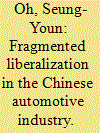

|
|
|
|
|
| Publication |
2013.
|
| Summary/Abstract |
This paper explains the extraordinary rise of the Beijing Hyundai Motor Company (BHMC), a joint venture between a state-owned enterprise run by the Beijing municipal government and Hyundai Motor Company. Within the span of three years, the BHMC soared to become China's second-ranked automotive manufacturer in terms of units sold. I highlight the role of the Beijing municipal government in creating favourable market conditions for the BHMC during its initial operation phase (2002-2005). The Beijing municipal government selectively adopted protectionist measures and liberalizing measures to promote its locally based company. I characterize this practice as fragmented liberalization, a system through which sub-national governments discriminately apply WTO or central government regulations to promote their local joint venture partner. In so doing, I also challenge the existing assumption that multinational companies are the drivers of economic liberalization, by showing Hyundai's support for local protectionism and industrial policy at the sub-national level.
|
|
|
|
|
|
|
|
|
|
|
|
|
|
|
|
| 5 |
ID:
102774
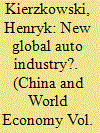

|
|
|
|
|
| Publication |
2011.
|
| Summary/Abstract |
This paper brings together a number of robust trade models to shed some light on the likely evolution of the global automotive industry. Vertical product differentiation, intra-industry trade and fragmentation of production leading to international outsourcing are important features of the existing global automotive sector. The global automotive sector will most likely experience groundbreaking changes over the coming decades. The sector is confronted with a multidimensional technological revolution spurred by radical product innovation, shifts in customer demand and government incentives. A dominant driver will be growing public concern about climate change. China and India might well become leading players by 2050, if not earlier.
|
|
|
|
|
|
|
|
|
|
|
|
|
|
|
|
| 6 |
ID:
190693
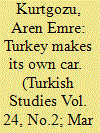

|
|
|
|
|
| Summary/Abstract |
This paper focuses on the history of Turkey’s efforts to establish a national automotive industry, which culminated in a state-driven project to build a Turkish automobile, the Devrim (Revolution), in 1961. The outcome of the project was three prototypes unveiled in Republic Day ceremonies, but quickly left in oblivion afterwards. This paper investigates the possible causes of the termination of the project, arguing that building a Turkish car had great symbolic significance for the identity of a nation in the quest for modernization and Westernization. The project was difficult to sustain considering the vexed political and ideological motivations invested in it.
|
|
|
|
|
|
|
|
|
|
|
|
|
|
|
|